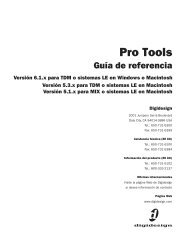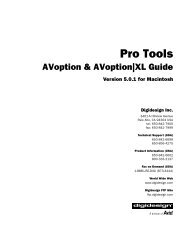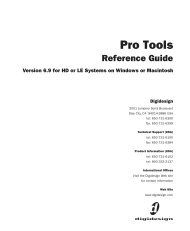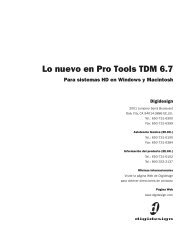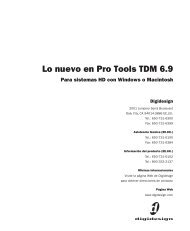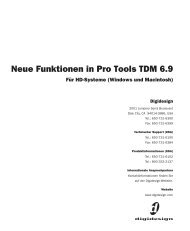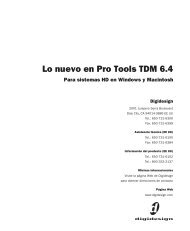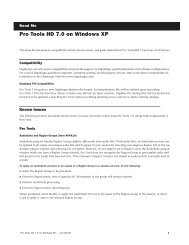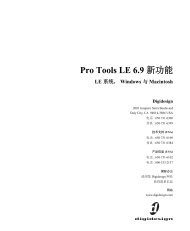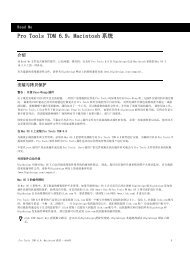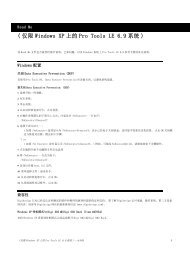5.1 DigiRack Plug-Ins Guide - Digidesign Support Archives
5.1 DigiRack Plug-Ins Guide - Digidesign Support Archives
5.1 DigiRack Plug-Ins Guide - Digidesign Support Archives
You also want an ePaper? Increase the reach of your titles
YUMPU automatically turns print PDFs into web optimized ePapers that Google loves.
Dynamics II<br />
There are five types of <strong>DigiRack</strong> dynamics processors:<br />
Compressor, Limiter, Gate, Expander/Gate<br />
and De-esser.<br />
Compressor II<br />
The Compressor reduces the dynamic range of<br />
signals that exceed a selected threshold by a specific<br />
amount. The increase of input signal<br />
needed to cause a 1dB increase in the output signal<br />
of the compressor is called the compression<br />
ratio. With a ratio of 4:1, for example, an 8dB increase<br />
of input produces a 2dB increase in the<br />
output.<br />
Audio material often varies in loudness, and can<br />
be above the threshold at one moment and below<br />
it the next. The Attack slider sets the compressor’s<br />
response time, or attack. The Release<br />
slider sets the amount of time that it takes for<br />
the compressor’s gain to return to its original<br />
level.<br />
Using Compression Effectively<br />
To use compression most effectively, the attack<br />
time should be set so that signals exceed the<br />
threshold level long enough to cause an increase<br />
in the average level. This helps ensure that gain<br />
reduction doesn’t decrease the overall volume.<br />
Release times should be set long enough that if<br />
signal levels repeatedly rise above the threshold,<br />
they cause gain reduction only once. If the release<br />
time is too long, a loud section of the audio<br />
material could cause gain reduction that persists<br />
through a soft section. Of course, compression<br />
has many creative uses that break these rules.<br />
The Compressor has built-in metering that allows<br />
you to monitor the amount of gain reduction<br />
taking place. The gain reduction meter usually<br />
remains at 0 level when the input signal is<br />
below the threshold and falls to the left to show<br />
the amount of gain reduction in decibels when<br />
the input signal exceeds the threshold.<br />
Compressor II plug-in Compressor settings created in version 5.x<br />
and later of Pro Tools are not compatible<br />
with earlier versions. Saving a session in a<br />
pre- 5.x format will cause Compressor settings<br />
to be lost.<br />
Compressor Parameters:<br />
Phase Invert Inverts the phase (polarity) of the<br />
input signal, allowing you to change frequency<br />
response characteristics between multi-miked<br />
sources or to correct for miswired microphone<br />
cables.<br />
Phase Invert<br />
Gain Provides overall output gain adjustment. It<br />
allows you to compensate for heavily compressed<br />
signals.<br />
Chapter 4: <strong>DigiRack</strong> Real-Time TDM and RTAS <strong>Plug</strong>-<strong>Ins</strong> 27



